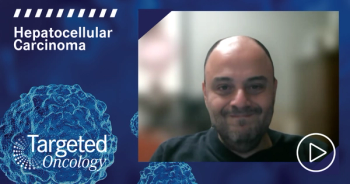
Atezolizumab/Bevacizumab for HCC: Toxicity Management
Episodes in this series

Richard S. Finn, MD: Bevacizumab and the risk of bleeding has always been a concern. What types of patients are considered high risk for bleeding? I don’t mean outside of the GI [gastrointestinal] tract. I specifically mean someone who has an endoscopy. Who’s at high risk of bleeding?
Catherine Frenette, MD: Patients at high risk for bleeding would include those with large esophageal varices, or large gastric varices. Also, sometimes with esophageal varices, we grade them—grade 2 or grade 3. Those patients are at risk for bleeding. We also look at what we call high-risk stigmata, which are red wale signs. I explain to my Fellows and medical school students that a red wale sign occurs when the wall of the vein is so thin that you can see the blood through it. That’s a high-risk stigmata, and that’s a bit scary. Those are the patients we worry about.
We do know that patients who have more advanced liver disease—Child-Pugh class B and Child-Pugh class C cirrhosis—are at higher risk of bleeding, even with small varices. But generally, most people have not yet been putting those patients with more advanced liver disease on atezolizumab/bevacizumab because of that concern of bleeding.
Richard S. Finn, MD: If I’m considering a patient for systemic treatment, at this point I need to come up with a reason why I wouldn’t give them atezolizumab/bevacizumab. The regimen is so active, and it’s improving overall survival. To me, it probably would be considered the frontline standard of care.
Michael, what are your thought about its place in our management?
Michael A. Morse, MD, FACP, MHS: I would agree. In general, that’s true. Remember, as Catherine pointed out, these are Child-Pugh class A patients who were studied. We don’t know what the impact is going to be, frankly, in my practice the more common are the Child-Pugh class B patients. We also don’t know about the people who may start out as Child-Pugh class B or Child-Pugh class C but see Catherine and have their liver disease managed and slide back into a better Child-Pugh classification. We don’t know how those people are going to fare.
I think while this is relatively new and people are getting experience with it, it’s best to understand the Child-Pugh class A patients are those for whom activity was seen. We don’t know what the activity would be like in others and what the safety data are.
Obviously, there are some other subgroups of patients for whom we would all agree are not appropriate candidates, for example, those who need a liver transplant. At our center, we’re certainly not willing to give a checkpoint blockade in that scenario. There are a few patients who have other very severe autoimmune diseases for whom we have to be careful. There are some patients for whom we can’t control their varices.
Catherine, I’m interested in people with gastric varices, because those sound like they’re more difficult to manage than esophageal varices?
Catherine Frenette, MD: They very much are. Esophageal varices are more of an up and down tube. When you band those, they scar down nicely. Generally, they do well. There’s always a risk of post-banding ulcer bleeding, which generally occurs 7 to 10 days after the banding event. So you have to wait and check.
The gastric varices are more of a bunch of grapes, in regard to configuration. When you band gastric varices, oftentimes when you get that post-banding ulcer it can erode into the next varix and actually worsen bleeding. It’s very scary, and they can be quite difficult.
We’re coming up with other ways to treat gastric varices. We’re doing EUS [endoscopic ultrasound] glue or coil injections. We’ve done something called a balloon-occluded retrograde transvenous obliteration, where we actually can sneak up through a splenorenal shunt and embolize them from the inside. Obviously, that requires a specialty center, but gastric varices can be very difficult.
Transcript edited for clarity.









































